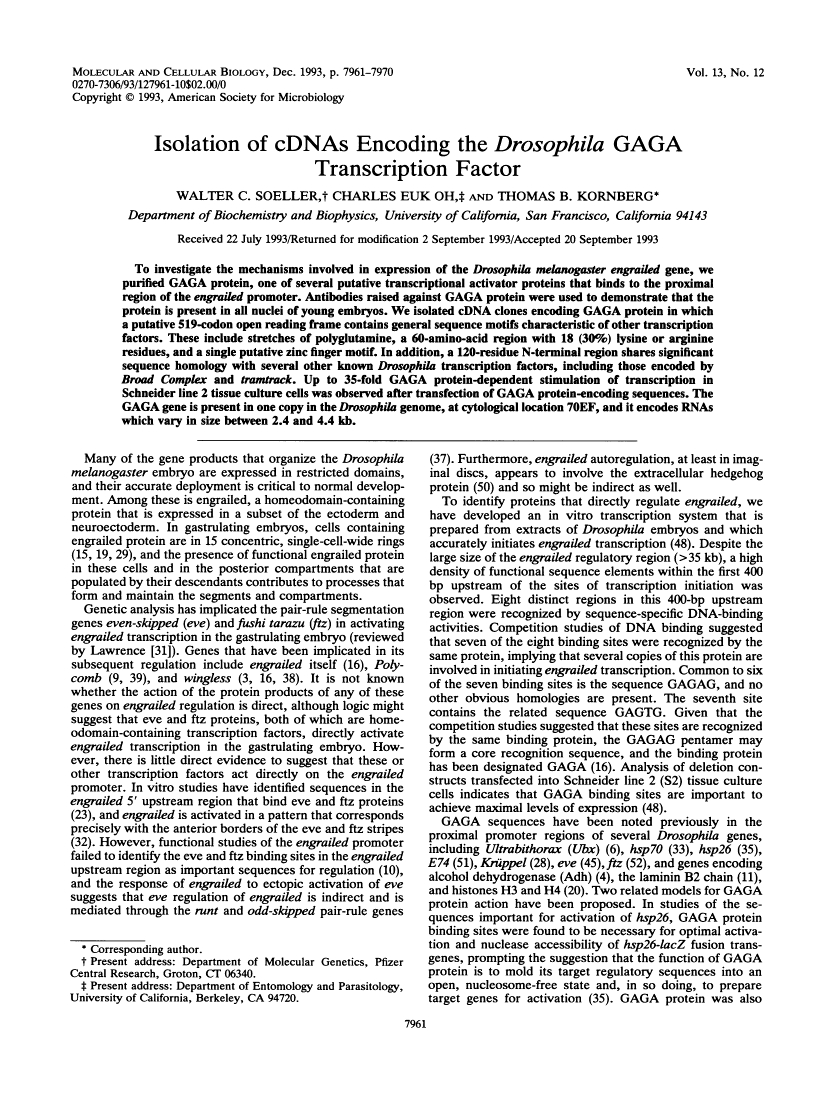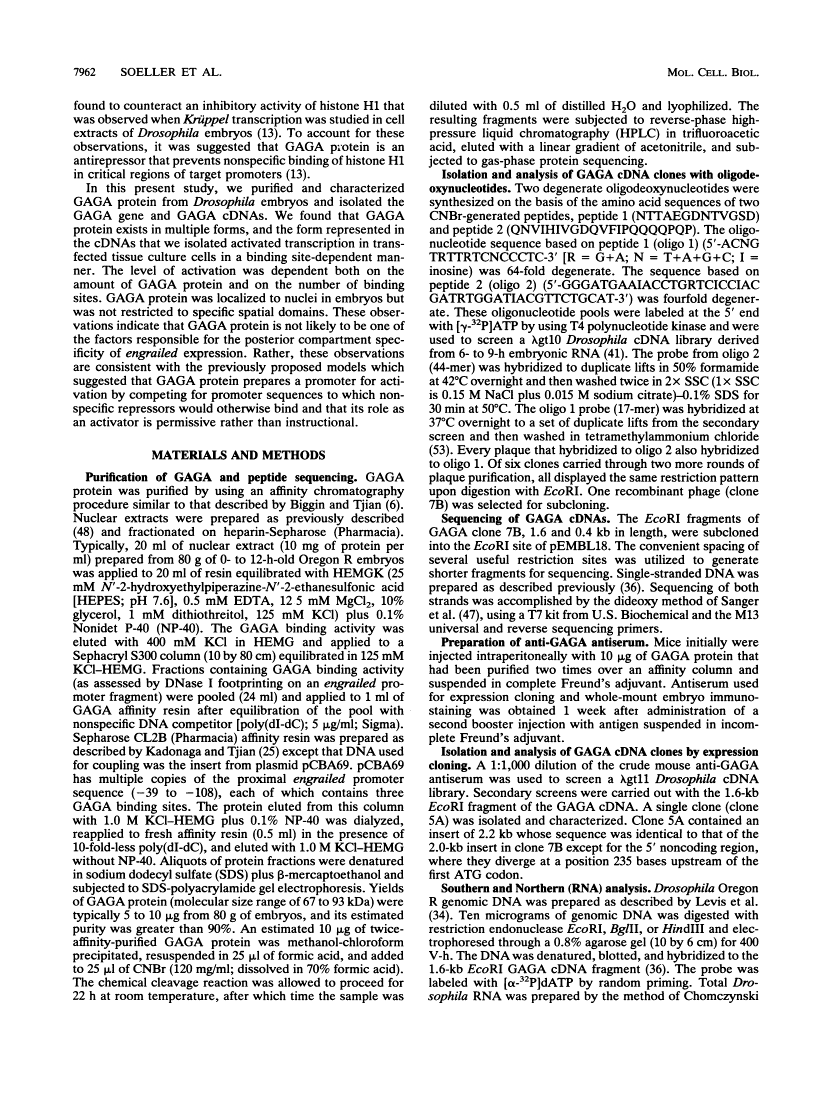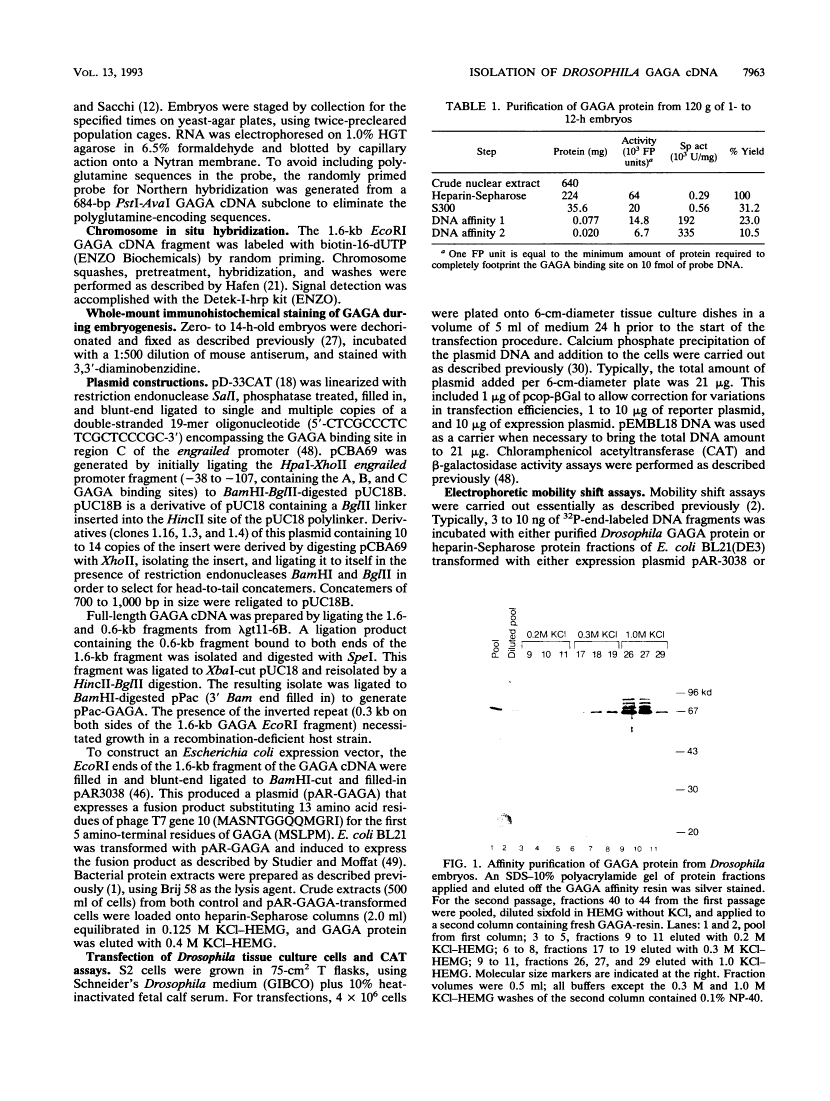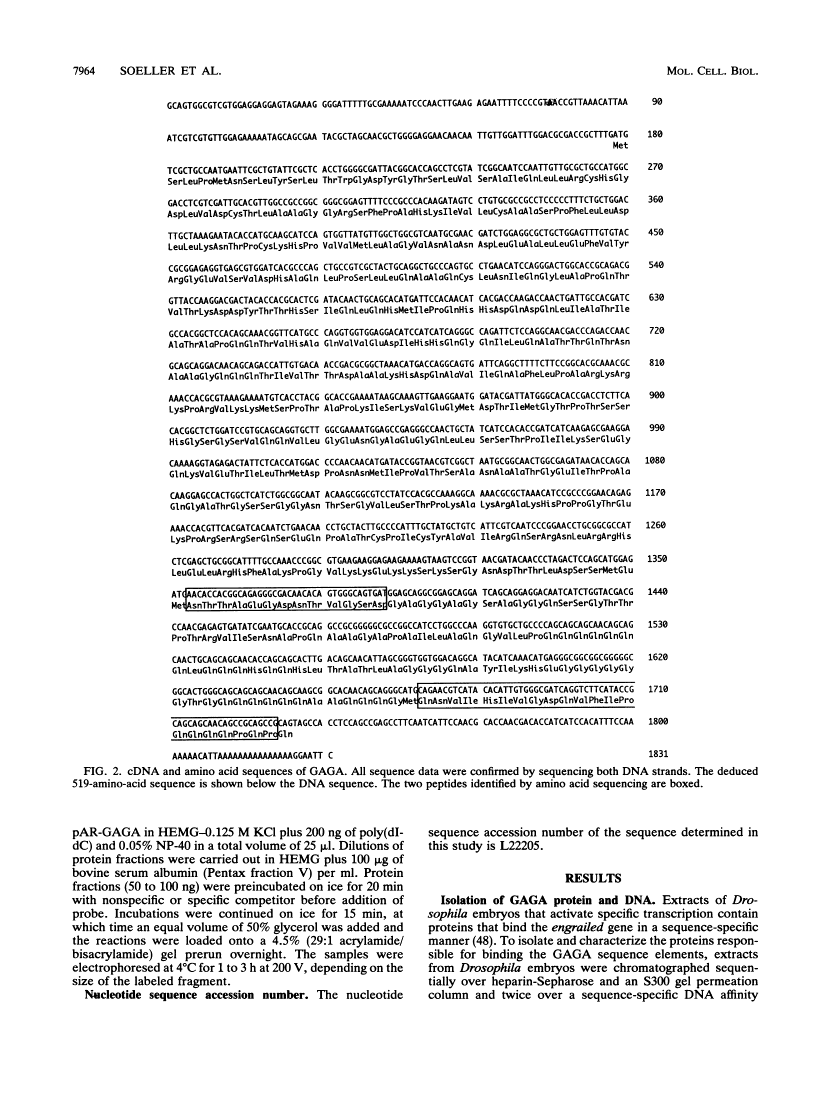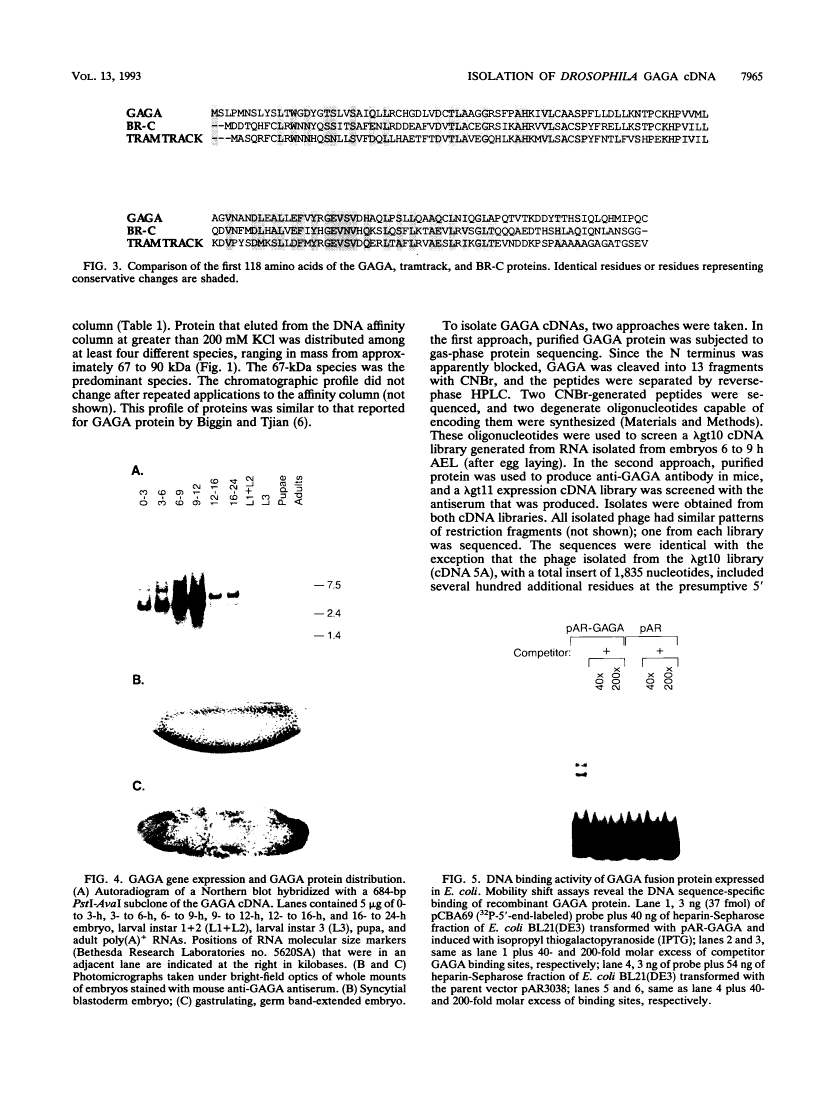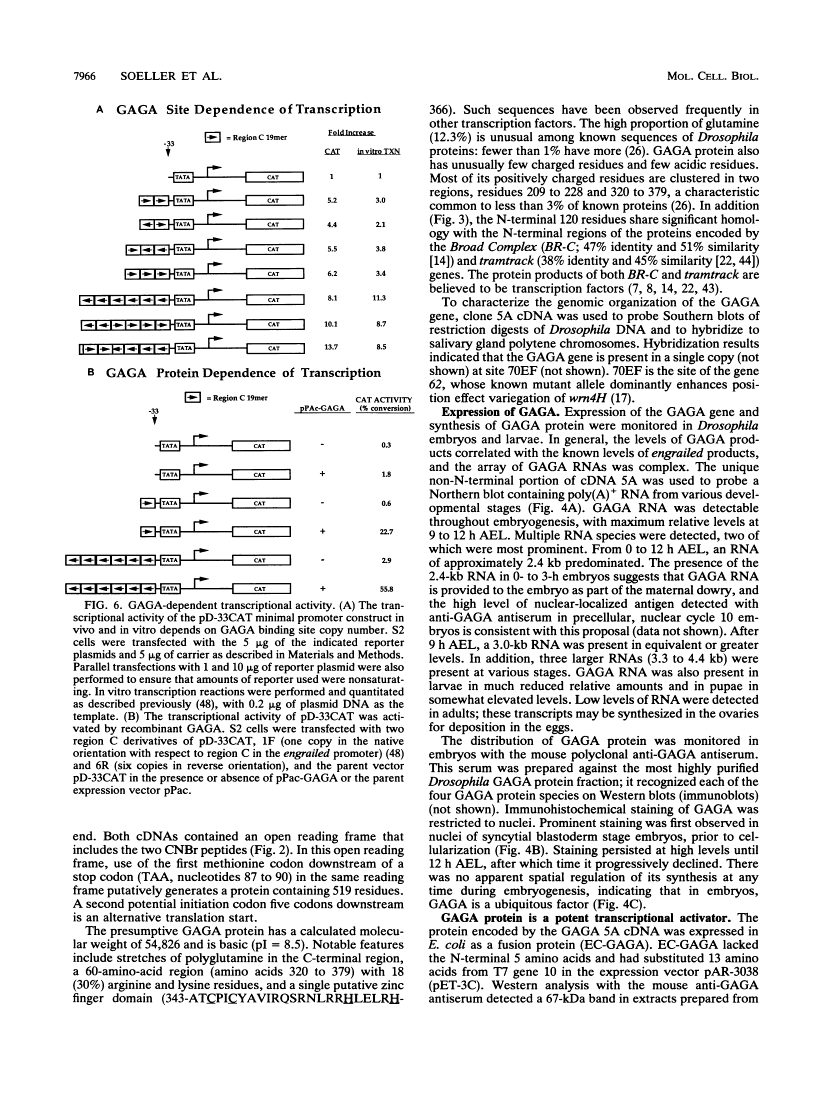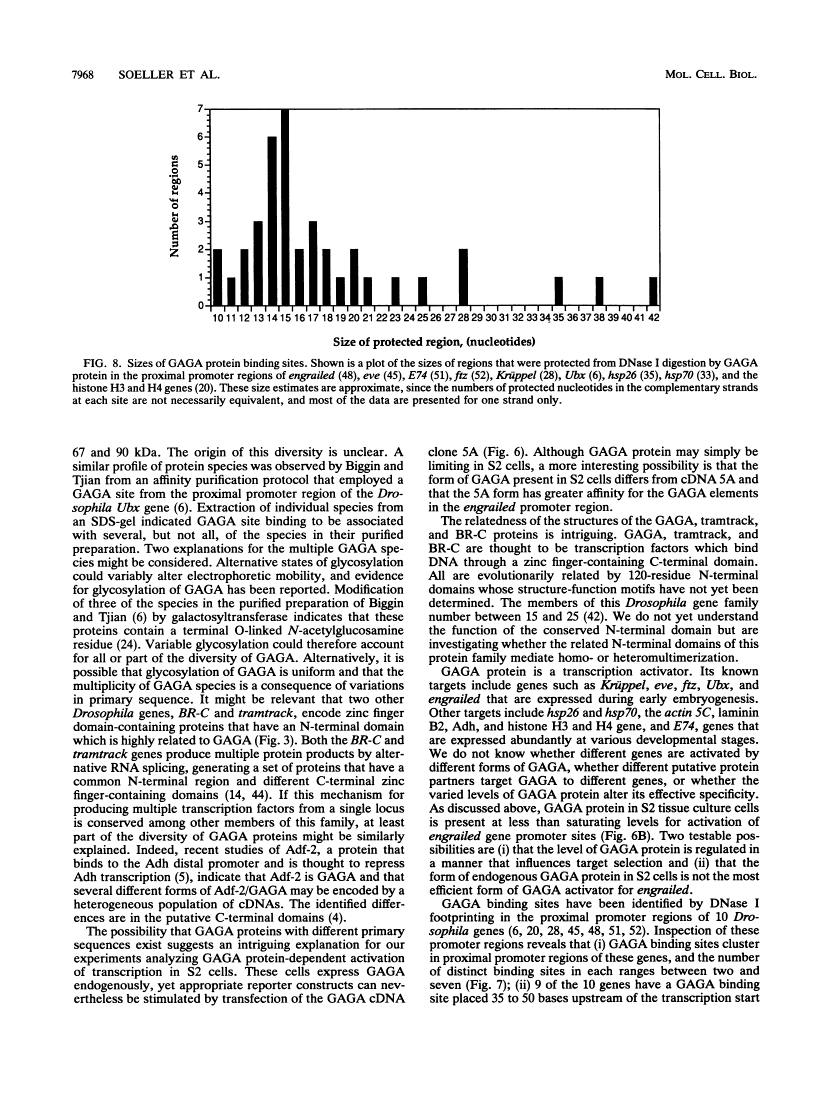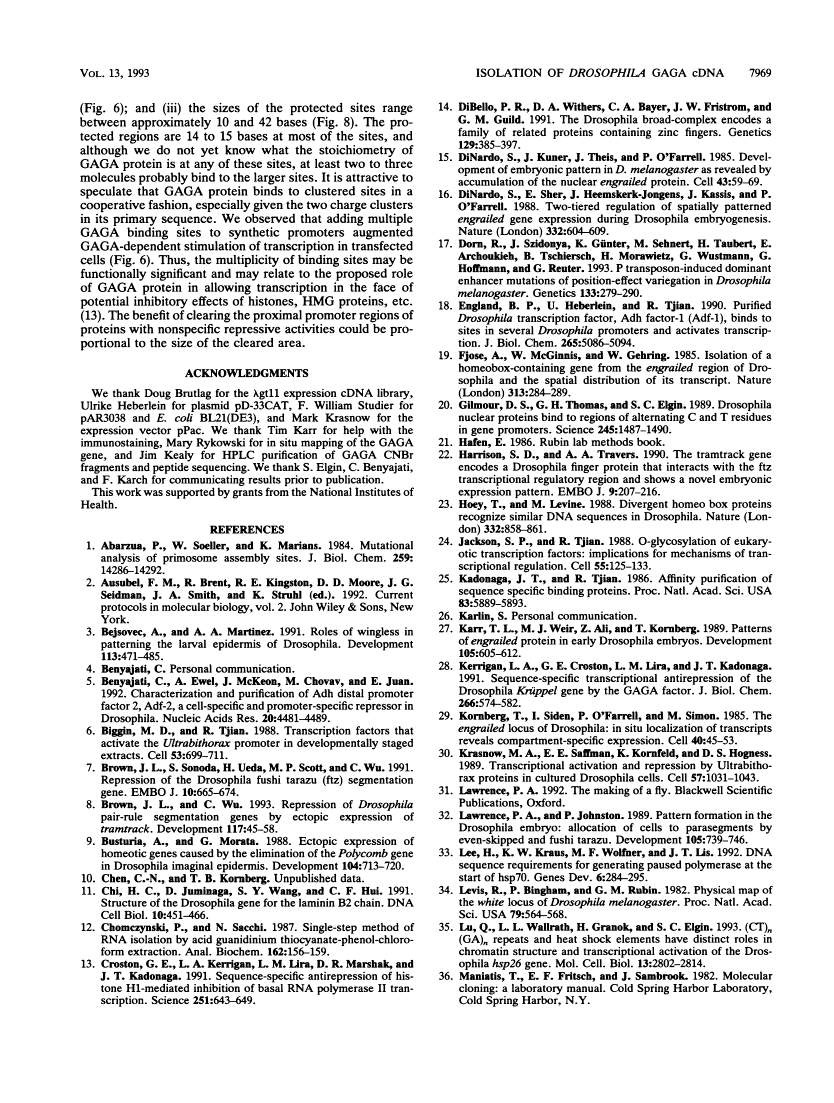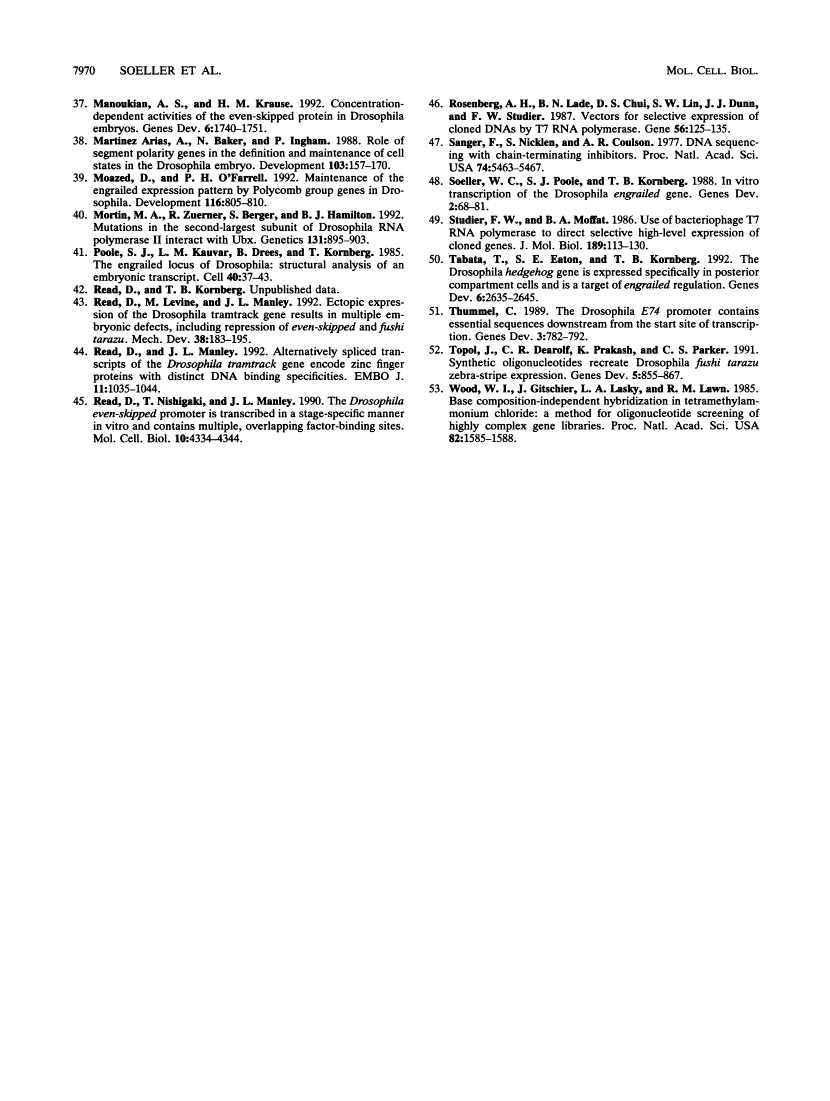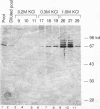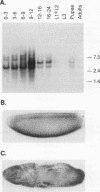Abstract
Free full text

Isolation of cDNAs encoding the Drosophila GAGA transcription factor.
Abstract
To investigate the mechanisms involved in expression of the Drosophila melanogaster engrailed gene, we purified GAGA protein, one of several putative transcriptional activator proteins that binds to the proximal region of the engrailed promoter. Antibodies raised against GAGA protein were used to demonstrate that the protein is present in all nuclei of young embryos. We isolated cDNA clones encoding GAGA protein in which a putative 519-codon open reading frame contains general sequence motifs characteristic of other transcription factors. These include stretches of polyglutamine, a 60-amino-acid region with 18 (30%) lysine or arginine residues, and a single putative zinc finger motif. In addition, a 120-residue N-terminal region shares significant sequence homology with several other known Drosophila transcription factors, including those encoded by Broad Complex and tramtrack. Up to 35-fold GAGA protein-dependent stimulation of transcription in Schneider line 2 tissue culture cells was observed after transfection of GAGA protein-encoding sequences. The GAGA gene is present in one copy in the Drosophila genome, at cytological location 70EF, and it encodes RNAs which vary in size between 2.4 and 4.4 kb.
Full text
Full text is available as a scanned copy of the original print version. Get a printable copy (PDF file) of the complete article (2.0M), or click on a page image below to browse page by page. Links to PubMed are also available for Selected References.
Images in this article
Selected References
These references are in PubMed. This may not be the complete list of references from this article.
- Abarzúa P, Soeller W, Marians KJ. Mutational analysis of primosome assembly sites. I. Distinct classes of mutants in the pBR322 Escherichia coli factor Y DNA effector sequences. J Biol Chem. 1984 Nov 25;259(22):14286–14292. [Abstract] [Google Scholar]
- Bejsovec A, Martinez Arias A. Roles of wingless in patterning the larval epidermis of Drosophila. Development. 1991 Oct;113(2):471–485. [Abstract] [Google Scholar]
- Benyajati C, Ewel A, McKeon J, Chovav M, Juan E. Characterization and purification of Adh distal promoter factor 2, Adf-2, a cell-specific and promoter-specific repressor in Drosophila. Nucleic Acids Res. 1992 Sep 11;20(17):4481–4489. [Europe PMC free article] [Abstract] [Google Scholar]
- Biggin MD, Tjian R. Transcription factors that activate the Ultrabithorax promoter in developmentally staged extracts. Cell. 1988 Jun 3;53(5):699–711. [Abstract] [Google Scholar]
- Brown JL, Sonoda S, Ueda H, Scott MP, Wu C. Repression of the Drosophila fushi tarazu (ftz) segmentation gene. EMBO J. 1991 Mar;10(3):665–674. [Europe PMC free article] [Abstract] [Google Scholar]
- Brown JL, Wu C. Repression of Drosophila pair-rule segmentation genes by ectopic expression of tramtrack. Development. 1993 Jan;117(1):45–58. [Abstract] [Google Scholar]
- Busturia A, Morata G. Ectopic expression of homeotic genes caused by the elimination of the Polycomb gene in Drosophila imaginal epidermis. Development. 1988 Dec;104(4):713–720. [Abstract] [Google Scholar]
- Chi HC, Juminaga D, Wang SY, Hui CF. Structure of the Drosophila gene for the laminin B2 chain. DNA Cell Biol. 1991 Jul-Aug;10(6):451–466. [Abstract] [Google Scholar]
- Chomczynski P, Sacchi N. Single-step method of RNA isolation by acid guanidinium thiocyanate-phenol-chloroform extraction. Anal Biochem. 1987 Apr;162(1):156–159. [Abstract] [Google Scholar]
- Croston GE, Kerrigan LA, Lira LM, Marshak DR, Kadonaga JT. Sequence-specific antirepression of histone H1-mediated inhibition of basal RNA polymerase II transcription. Science. 1991 Feb 8;251(4994):643–649. [Abstract] [Google Scholar]
- DiBello PR, Withers DA, Bayer CA, Fristrom JW, Guild GM. The Drosophila Broad-Complex encodes a family of related proteins containing zinc fingers. Genetics. 1991 Oct;129(2):385–397. [Europe PMC free article] [Abstract] [Google Scholar]
- DiNardo S, Kuner JM, Theis J, O'Farrell PH. Development of embryonic pattern in D. melanogaster as revealed by accumulation of the nuclear engrailed protein. Cell. 1985 Nov;43(1):59–69. [Europe PMC free article] [Abstract] [Google Scholar]
- DiNardo S, Sher E, Heemskerk-Jongens J, Kassis JA, O'Farrell PH. Two-tiered regulation of spatially patterned engrailed gene expression during Drosophila embryogenesis. Nature. 1988 Apr 14;332(6165):604–609. [Europe PMC free article] [Abstract] [Google Scholar]
- Dorn R, Szidonya J, Korge G, Sehnert M, Taubert H, Archoukieh E, Tschiersch B, Morawietz H, Wustmann G, Hoffmann G, et al. P transposon-induced dominant enhancer mutations of position-effect variegation in Drosophila melanogaster. Genetics. 1993 Feb;133(2):279–290. [Europe PMC free article] [Abstract] [Google Scholar]
- England BP, Heberlein U, Tjian R. Purified Drosophila transcription factor, Adh distal factor-1 (Adf-1), binds to sites in several Drosophila promoters and activates transcription. J Biol Chem. 1990 Mar 25;265(9):5086–5094. [Abstract] [Google Scholar]
- Fjose A, McGinnis WJ, Gehring WJ. Isolation of a homoeo box-containing gene from the engrailed region of Drosophila and the spatial distribution of its transcripts. Nature. 1985 Jan 24;313(6000):284–289. [Abstract] [Google Scholar]
- Gilmour DS, Thomas GH, Elgin SC. Drosophila nuclear proteins bind to regions of alternating C and T residues in gene promoters. Science. 1989 Sep 29;245(4925):1487–1490. [Abstract] [Google Scholar]
- Harrison SD, Travers AA. The tramtrack gene encodes a Drosophila finger protein that interacts with the ftz transcriptional regulatory region and shows a novel embryonic expression pattern. EMBO J. 1990 Jan;9(1):207–216. [Europe PMC free article] [Abstract] [Google Scholar]
- Hoey T, Levine M. Divergent homeo box proteins recognize similar DNA sequences in Drosophila. Nature. 1988 Apr 28;332(6167):858–861. [Abstract] [Google Scholar]
- Jackson SP, Tjian R. O-glycosylation of eukaryotic transcription factors: implications for mechanisms of transcriptional regulation. Cell. 1988 Oct 7;55(1):125–133. [Abstract] [Google Scholar]
- Kadonaga JT, Tjian R. Affinity purification of sequence-specific DNA binding proteins. Proc Natl Acad Sci U S A. 1986 Aug;83(16):5889–5893. [Europe PMC free article] [Abstract] [Google Scholar]
- Karr TL, Weir MP, Ali Z, Kornberg T. Patterns of engrailed protein in early Drosophila embryos. Development. 1989 Mar;105(3):605–612. [Abstract] [Google Scholar]
- Kerrigan LA, Croston GE, Lira LM, Kadonaga JT. Sequence-specific transcriptional antirepression of the Drosophila Krüppel gene by the GAGA factor. J Biol Chem. 1991 Jan 5;266(1):574–582. [Abstract] [Google Scholar]
- Kornberg T, Sidén I, O'Farrell P, Simon M. The engrailed locus of Drosophila: in situ localization of transcripts reveals compartment-specific expression. Cell. 1985 Jan;40(1):45–53. [Abstract] [Google Scholar]
- Krasnow MA, Saffman EE, Kornfeld K, Hogness DS. Transcriptional activation and repression by Ultrabithorax proteins in cultured Drosophila cells. Cell. 1989 Jun 16;57(6):1031–1043. [Abstract] [Google Scholar]
- Tix S, Minden JS, Technau GM. Pre-existing neuronal pathways in the developing optic lobes of Drosophila. Development. 1989 Apr;105(4):739–746. [Abstract] [Google Scholar]
- Lee H, Kraus KW, Wolfner MF, Lis JT. DNA sequence requirements for generating paused polymerase at the start of hsp70. Genes Dev. 1992 Feb;6(2):284–295. [Abstract] [Google Scholar]
- Levis R, Bingham PM, Rubin GM. Physical map of the white locus of Drosophila melanogaster. Proc Natl Acad Sci U S A. 1982 Jan;79(2):564–568. [Europe PMC free article] [Abstract] [Google Scholar]
- Lu Q, Wallrath LL, Granok H, Elgin SC. (CT)n (GA)n repeats and heat shock elements have distinct roles in chromatin structure and transcriptional activation of the Drosophila hsp26 gene. Mol Cell Biol. 1993 May;13(5):2802–2814. [Europe PMC free article] [Abstract] [Google Scholar]
- Manoukian AS, Krause HM. Concentration-dependent activities of the even-skipped protein in Drosophila embryos. Genes Dev. 1992 Sep;6(9):1740–1751. [Abstract] [Google Scholar]
- Martizez Arias A, Baker NE, Ingham PW. Role of segment polarity genes in the definition and maintenance of cell states in the Drosophila embryo. Development. 1988 May;103(1):157–170. [Abstract] [Google Scholar]
- Moazed D, O'Farrell PH. Maintenance of the engrailed expression pattern by Polycomb group genes in Drosophila. Development. 1992 Nov;116(3):805–810. [Europe PMC free article] [Abstract] [Google Scholar]
- Mortin MA, Zuerner R, Berger S, Hamilton BJ. Mutations in the second-largest subunit of Drosophila RNA polymerase II interact with Ubx. Genetics. 1992 Aug;131(4):895–903. [Europe PMC free article] [Abstract] [Google Scholar]
- Poole SJ, Kauvar LM, Drees B, Kornberg T. The engrailed locus of Drosophila: structural analysis of an embryonic transcript. Cell. 1985 Jan;40(1):37–43. [Abstract] [Google Scholar]
- Read D, Levine M, Manley JL. Ectopic expression of the Drosophila tramtrack gene results in multiple embryonic defects, including repression of even-skipped and fushi tarazu. Mech Dev. 1992 Sep;38(3):183–195. [Abstract] [Google Scholar]
- Read D, Manley JL. Alternatively spliced transcripts of the Drosophila tramtrack gene encode zinc finger proteins with distinct DNA binding specificities. EMBO J. 1992 Mar;11(3):1035–1044. [Europe PMC free article] [Abstract] [Google Scholar]
- Read D, Nishigaki T, Manley JL. The Drosophila even-skipped promoter is transcribed in a stage-specific manner in vitro and contains multiple, overlapping factor-binding sites. Mol Cell Biol. 1990 Aug;10(8):4334–4344. [Europe PMC free article] [Abstract] [Google Scholar]
- Rosenberg AH, Lade BN, Chui DS, Lin SW, Dunn JJ, Studier FW. Vectors for selective expression of cloned DNAs by T7 RNA polymerase. Gene. 1987;56(1):125–135. [Abstract] [Google Scholar]
- Sanger F, Nicklen S, Coulson AR. DNA sequencing with chain-terminating inhibitors. Proc Natl Acad Sci U S A. 1977 Dec;74(12):5463–5467. [Europe PMC free article] [Abstract] [Google Scholar]
- Soeller WC, Poole SJ, Kornberg T. In vitro transcription of the Drosophila engrailed gene. Genes Dev. 1988 Jan;2(1):68–81. [Abstract] [Google Scholar]
- Studier FW, Moffatt BA. Use of bacteriophage T7 RNA polymerase to direct selective high-level expression of cloned genes. J Mol Biol. 1986 May 5;189(1):113–130. [Abstract] [Google Scholar]
- Tabata T, Eaton S, Kornberg TB. The Drosophila hedgehog gene is expressed specifically in posterior compartment cells and is a target of engrailed regulation. Genes Dev. 1992 Dec;6(12B):2635–2645. [Abstract] [Google Scholar]
- Thummel CS. The Drosophila E74 promoter contains essential sequences downstream from the start site of transcription. Genes Dev. 1989 Jun;3(6):782–792. [Abstract] [Google Scholar]
- Topol J, Dearolf CR, Prakash K, Parker CS. Synthetic oligonucleotides recreate Drosophila fushi tarazu zebra-stripe expression. Genes Dev. 1991 May;5(5):855–867. [Abstract] [Google Scholar]
- Wood WI, Gitschier J, Lasky LA, Lawn RM. Base composition-independent hybridization in tetramethylammonium chloride: a method for oligonucleotide screening of highly complex gene libraries. Proc Natl Acad Sci U S A. 1985 Mar;82(6):1585–1588. [Europe PMC free article] [Abstract] [Google Scholar]
Associated Data
Articles from Molecular and Cellular Biology are provided here courtesy of Taylor & Francis
Full text links
Read article at publisher's site: https://doi.org/10.1128/mcb.13.12.7961-7970.1993
Read article for free, from open access legal sources, via Unpaywall:
https://europepmc.org/articles/pmc364868?pdf=render
Free to read at mcb.asm.org
http://mcb.asm.org/cgi/content/abstract/13/12/7961
Free after 4 months at mcb.asm.org
http://mcb.asm.org/cgi/reprint/13/12/7961
Citations & impact
Impact metrics
Citations of article over time
Smart citations by scite.ai
Explore citation contexts and check if this article has been
supported or disputed.
https://scite.ai/reports/10.1128/mcb.13.12.7961-7970.1993
Article citations
Promoter architecture of Drosophila genes regulated by Myocyte enhancer factor-2.
PLoS One, 17(7):e0271554, 21 Jul 2022
Cited by: 0 articles | PMID: 35862472 | PMCID: PMC9302807
Kinetic principles underlying pioneer function of GAGA transcription factor in live cells.
Nat Struct Mol Biol, 29(7):665-676, 14 Jul 2022
Cited by: 27 articles | PMID: 35835866 | PMCID: PMC10177624
Multi-Scale Organization of the Drosophila melanogaster Genome.
Genes (Basel), 12(6):817, 27 May 2021
Cited by: 11 articles | PMID: 34071789 | PMCID: PMC8228293
Review Free full text in Europe PMC
GAF is essential for zygotic genome activation and chromatin accessibility in the early Drosophila embryo.
Elife, 10:e66668, 15 Mar 2021
Cited by: 64 articles | PMID: 33720012 | PMCID: PMC8079149
GAGA factor: a multifunctional pioneering chromatin protein.
Cell Mol Life Sci, 78(9):4125-4141, 02 Feb 2021
Cited by: 26 articles | PMID: 33528710 | PMCID: PMC8815297
Review Free full text in Europe PMC
Go to all (90) article citations
Data
Similar Articles
To arrive at the top five similar articles we use a word-weighted algorithm to compare words from the Title and Abstract of each citation.
The pipsqueak protein of Drosophila melanogaster binds to GAGA sequences through a novel DNA-binding domain.
J Biol Chem, 273(43):28504-28509, 01 Oct 1998
Cited by: 56 articles | PMID: 9774480
Comparison of the GAGA factor genes of Drosophila melanogaster and Drosophila virilis reveals high conservation of GAGA factor structure beyond the BTB/POZ and DNA-binding domains.
Dev Genes Evol, 208(8):447-456, 01 Oct 1998
Cited by: 8 articles | PMID: 9799425
Molecular cloning and characterization of a transcription factor for the copia retrotransposon with homology to the BTB-containing lola neurogenic factor.
Mol Cell Biol, 17(1):482-494, 01 Jan 1997
Cited by: 25 articles | PMID: 8972229 | PMCID: PMC231773
Chromatin. Ga-ga over GAGA factor.
Curr Biol, 5(3):238-241, 01 Mar 1995
Cited by: 103 articles | PMID: 7780729
Review
